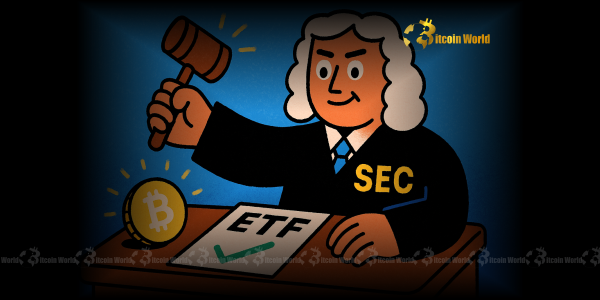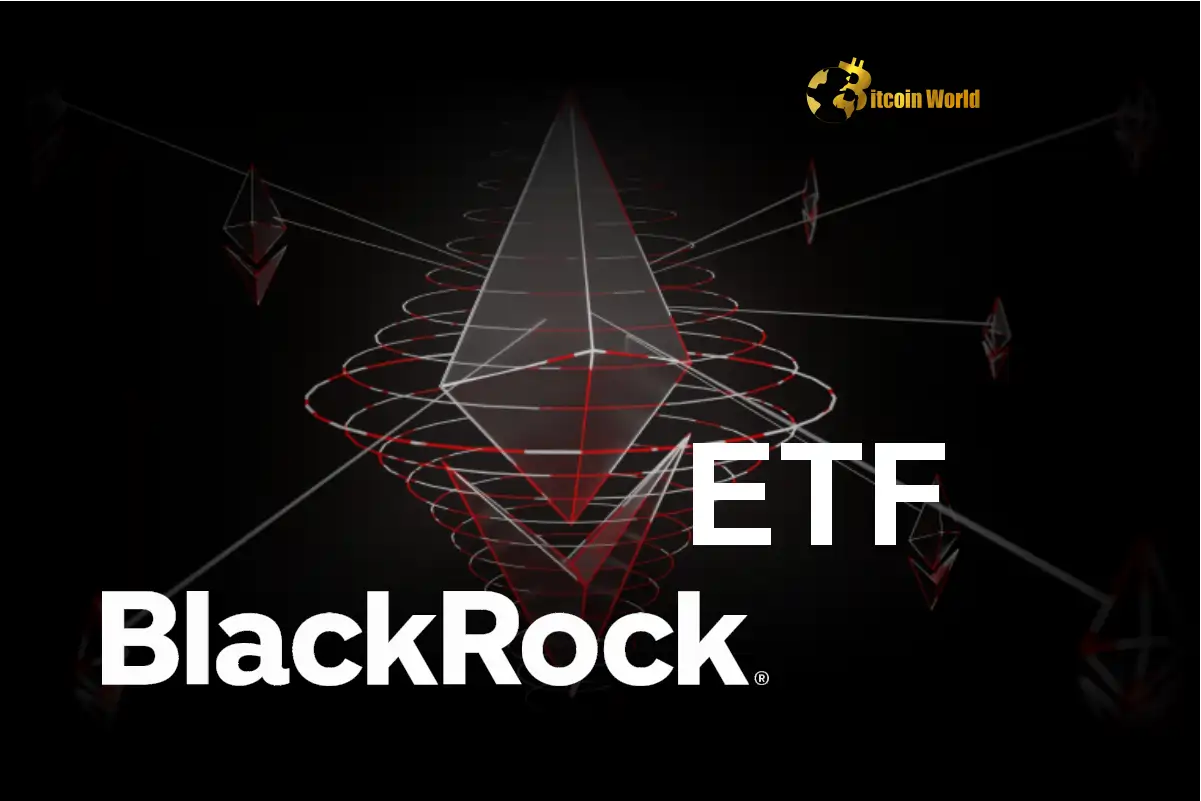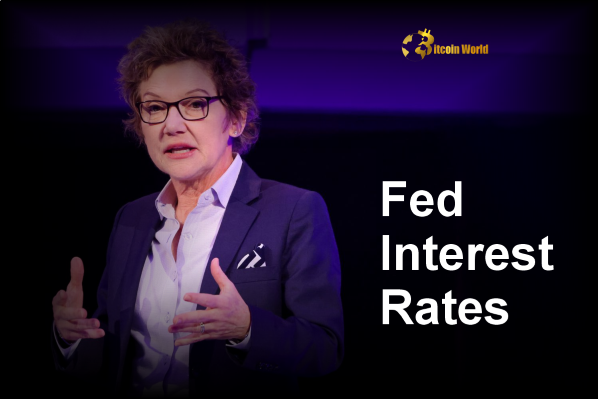BitcoinWorld

SEC ETF Breakthrough: Simplifying the Token-Based ETF Listing Process
The world of cryptocurrency is constantly evolving, and one of the most anticipated developments has been the integration of digital assets into traditional financial vehicles like Exchange-Traded Funds (ETFs). For years, the path to launching a SEC ETF that holds cryptocurrencies directly has been fraught with regulatory hurdles, extensive paperwork, and prolonged waiting periods. However, a significant shift appears to be on the horizon, promising to streamline this complex journey and potentially unlock a new era for crypto investments.
What’s Driving the SEC ETF Breakthrough?
For a long time, the U.S. Securities and Exchange Commission (SEC) has maintained a cautious stance on crypto-related financial products, particularly those directly holding digital assets. The existing framework for listing new ETFs on exchanges, primarily through the 19b-4 filing process, has proven to be a cumbersome and often frustrating experience for issuers. This process requires exchanges to propose rule changes to list new products, which then undergo a lengthy review and public comment period by the SEC. It’s a resource-intensive endeavor, demanding significant time, legal expertise, and financial commitment from both the exchanges and the prospective ETF issuers.
The recent approval of spot Bitcoin ETFs, while a monumental step, still involved this arduous 19b-4 pathway for each individual product. Now, sources like Crypto in America host Eleanor Terrett indicate that the SEC is actively working with exchanges to develop general listing standards. This proactive approach suggests a recognition of the growing maturity of the digital asset market and an understanding that the current ad-hoc system is unsustainable for broader adoption. The goal is clear: to create a more efficient, predictable, and less burdensome route for bringing new token-based ETFs to market, fostering innovation while maintaining investor protection.
Unpacking the New Token-Based ETFs Listing Framework
The proposed shift is nothing short of revolutionary for the digital asset space. Instead of each new token-based ETF requiring a unique 19b-4 filing, the SEC is aiming for a system where a token, once it meets pre-defined listing criteria, would allow issuers to bypass this step entirely. Issuers would then only need to submit an S-1 Securities Registration Statement, which is a standard registration form for new securities offerings. Following this, the ETF could be listed on an exchange after a 75-day waiting period.
To illustrate the significance of this change, consider the contrast between the old and proposed new processes:
| Aspect | Current Process (e.g., Spot Bitcoin ETFs) | Proposed New Process (for Token-Based ETFs) |
|---|---|---|
| Primary Filing | 19b-4 Rule Change (by exchange) AND S-1 Registration (by issuer) | S-1 Registration (by issuer) ONLY |
| Regulatory Burden | High; lengthy SEC review, public comments, significant feedback loops | Significantly Reduced; streamlined review based on pre-set criteria |
| Approval Timeline | Variable, often many months to years for 19b-4 | Potentially faster; 75-day wait post S-1 submission for eligible tokens |
| Scope | Token-specific, requires individual approval for each new product/asset | Token-agnostic, applies to any token meeting general standards |
This simplified pathway is expected to dramatically reduce the paperwork and feedback burden on both the issuers, who currently face immense compliance costs, and the SEC itself, which has been overwhelmed by the volume of filings. It represents a move towards a more programmatic and less discretionary regulatory approach, which could foster greater predictability in the market.
Accelerating Crypto ETF Approval: Benefits and Hurdles
The implications of a streamlined crypto ETF approval process are vast, promising a cascade of benefits across the digital asset ecosystem:
- Increased Market Access: More ETFs means more avenues for traditional investors to gain exposure to cryptocurrencies without directly holding the underlying assets. This could lead to a significant inflow of capital from institutional and retail investors.
- Enhanced Liquidity: With more regulated products, liquidity in the underlying crypto markets could improve as institutional participants find easier entry points.
- Reduced Costs for Issuers: Less regulatory overhead translates to lower legal and operational costs for companies looking to launch these funds, potentially leading to more competitive fees for investors.
- Greater Innovation: A clearer path encourages more diverse token-based ETF offerings, moving beyond just Bitcoin and Ethereum to potentially include a wider array of digital assets.
- Regulatory Clarity: Establishing general listing standards provides much-needed clarity for the industry, allowing for better long-term planning and investment.
However, challenges remain. While the process may be streamlined, the SEC’s core mandate of investor protection will not diminish. The agency will still scrutinize the underlying assets, market manipulation concerns, and the robustness of the ETF’s structure. The exact criteria, once set, will dictate which tokens are eligible, and there will inevitably be a period of adjustment as the industry adapts to these new standards. Furthermore, the 75-day waiting period, while shorter than current 19b-4 timelines, still requires careful planning from issuers.
Key Criteria for ETF Listing Process: Market Cap, Volume, and Liquidity
While specific listing criteria have not yet been formally set or publicly detailed, early indications suggest that the SEC will focus on fundamental metrics that demonstrate a token’s maturity and stability. The reported considerations include market capitalization, trading volume, and liquidity. These are critical indicators that traditional finance regulators often rely on to assess the health and integrity of an asset market.
- Market Capitalization: This refers to the total value of all circulating units of a cryptocurrency (price per token multiplied by circulating supply). A higher market capitalization generally indicates a larger, more established, and less volatile asset. It suggests a broader investor base and greater resilience to price manipulation.
- Trading Volume: This measures the total amount of a specific cryptocurrency that has been traded over a given period (e.g., 24 hours). High trading volume signifies strong market interest and activity, making it easier for large orders to be filled without significantly impacting the price. It also suggests a more efficient price discovery mechanism.
- Liquidity: This refers to the ease with which an asset can be converted into cash without affecting its market price. For cryptocurrencies, high liquidity means there are many buyers and sellers, and trades can be executed quickly and efficiently. Illiquid assets are prone to significant price swings, making them riskier for ETF structures that need to manage redemptions and creations smoothly.
The SEC’s focus on these metrics is a pragmatic approach, leveraging established financial principles to evaluate novel assets. By setting clear, data-driven thresholds, the commission aims to ensure that only sufficiently robust and mature digital assets underpin these new ETFs, thereby mitigating risks for investors and maintaining market integrity. This structured approach to the ETF listing process is a significant step towards regulatory harmonization.
The Future Landscape of Digital Asset ETFs
This proactive move by the SEC could herald a new era for digital asset ETFs. If successful, it could pave the way for a broader range of token-based ETFs beyond just Bitcoin and Ethereum. Imagine ETFs based on leading DeFi tokens, layer-1 blockchain protocols, or even baskets of various digital assets, similar to sector-specific equity ETFs. This expansion would provide investors with diversified exposure to the rapidly growing crypto economy through familiar and regulated investment vehicles.
Such a development would also signify a deeper integration of the crypto market into the mainstream financial system. It could attract more institutional investors who are currently hesitant due to regulatory uncertainties or the complexities of direct crypto custody. The increased institutional participation, in turn, could bring greater stability and maturity to the crypto markets. While an SEC spokesperson declined to comment on the specifics, the ongoing discussions with exchanges are a strong indicator of the commission’s evolving strategy and a clear signal that the future of digital asset investment is increasingly intertwined with traditional finance.
Conclusion: A New Horizon for Crypto Investments
The SEC’s reported efforts to streamline the token-based ETF listing process mark a pivotal moment for the cryptocurrency industry. By moving towards general listing standards and simplifying the approval pathway, the commission is signaling a shift from reactive oversight to a more proactive and structured regulatory framework. This initiative promises to reduce significant burdens on issuers, accelerate the introduction of diverse crypto-backed financial products, and ultimately provide millions of investors with easier, regulated access to the burgeoning digital asset economy. While the specifics of the listing criteria are yet to be finalized, the focus on market capitalization, trading volume, and liquidity suggests a pragmatic approach aimed at fostering responsible innovation. The journey towards mainstream crypto adoption is long, but this potential breakthrough could be a monumental leap forward.
To learn more about the latest crypto market trends, explore our article on key developments shaping digital asset ETFs institutional adoption.
This post SEC ETF Breakthrough: Simplifying the Token-Based ETF Listing Process first appeared on BitcoinWorld and is written by Editorial Team





